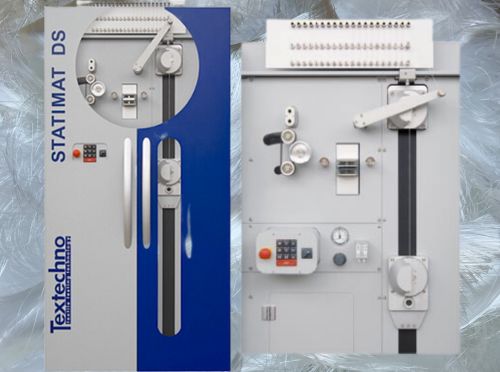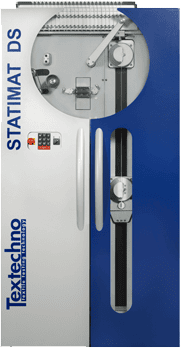Textile Instruments / TEXTECHNO
STATIMAT DS
Automatic Tensile, Count and Evenness Tester for Yarns and Threads STATIMAT DS
The STATIMAT DS represents the perfect testing solution for the most important yarn quality parameters – tenacity, count, evenness* and hairiness* – integrated in one instrument. The individual tests on each package presented by the 24 positions package changer are performed in succession without any operator interference.

Tasks of the quality control
on yarns and threads
The application range of the STATIMAT DS can be extended by using interchangeable load cells with a force-measuring range up to 1.500 N as well as other sample holders for tensile tests on fabrics, yarn skeins or cohesion force tests on slivers and rovings.
Learn More
In the production of staple fiber or filament yarns, as well as in twisting or texturizing processes, quality control plays a crucial role in ensuring the material properties necessary for trouble-free downstream processing and flawless final products. Simultaneously, regular yarn testing allows for the early detection of production process flaws, facilitating analysis of their causes and implementation of corrective measures.
The key yarn properties of utmost importance include tensile strength, elongation, mass uniformity, and linear density (yarn count). The assessment of these yarn properties involves static tensile testing, yarn uniformity assessments, and various yarn count testing methods, such as wrap reel and balance techniques.
However, conducting tests on yarn samples using different testing equipment one after another entails significant labor and financial investments, particularly when employing modern automatic computer-controlled testing equipment.

STATIMAT DS
This new model of the well-proven STATIMAT series of Textechno combines testing of tensile properties according to the CRE principle, unevenness, and count of yarn and thread in one tester. The essential advantage of such a combination of different test methods lies in the common use of peripheral components like package changer, threading mechanism for inserting the yarn sample into the test sections, yarn feeding device, waste yarn disposal, instrument housing with protective front panel, as well as control electronics including the PC-based Textechno TESTCONTROL system.
The three tests on each package presented by the package changer are performed in succession. Optionally it is possible to test unevenness and yarn count in one test run.
Test Methods
Tensile test
The essential features of this STATIMAT DS test procedure are the high clamping force of the pneumatic jaws for tensile tests up to 1000 N, the long path of the draw-off clamp for breaking extensions up to 1000 %, the quick yarn threading reducing idle time to only a few seconds, the forcemeasuring system with a range of 500 N (optional 1500 N), as well as high variability of the test process and the evaluation of the measured data.
In addition to the static tensile test, for instance according to ISO 2062 or ASTM D2256, D885, alternating load tests (hysteresis tests) are possible according to freely selectable programs, as well as creep and relaxation tests.
A yarn feeding device enables high-speed take-off of selected yarn lengths prior to starting the tensile test on a new package or between individual tensile tests. This means that tensile tests can be carried out on yarn lengths both from the package outer and inner layers.
Beside the standard automatic yarn clamps, various special clamps for manual introduction of the test sample are available. These enable tensile- and elasticity tests on fabrics and cohesion tests on slivers or rovings.
Yarn evenness test
A new innovative capacitor system enables capacitive testing of the mass unevenness according to ISO 16549 within a wide yarn count range by individual adaptation of the measuring sensor to the properties of the yarn material. As a new feature in yarn evenness testing the yarn tension can be monitored in order to ensure proper testing conditions. Measurable variables delivered by the system are the coeffi cient of variation of the mass distribution along the yarn length, the spectrogram, and for staple fi bre spun yarns the numbers of neps, thick and thin places.
In case of continuous multifi lament yarns, interlaces (entanglements), too, infl uence the uniformity of the yarn. A sophisticated optical sensor system serves for measuring the number as well as the regularity of interlaces both in fl at and textured yarns.
Yarn count test
In this test, e.g. according to ISO 2060 or ASTM D6587, a preselected yarn length, e.g. 100 m, is delivered by the yarn feeding device into a collection chamber, and subsequently the weight is measured. By using the principle of a vacuum conveyer the yarn is permanently in contact with the ambient (laboratory) climate.
In this way drying of the yarn as would occur with a compressed-air system does not happen. Another advantage is the yarn tension measurement during the test. If tension limits specifi ed by the relevant standards are exceeded, a correction is automatically made based on the same yarn‘s tensile properties.
Technical Data
Tensile test:
- 2 pneumatic yarn clamps, automatic threading by rotating gripper arm, min. gauge length 80 mm,
max. travel of draw-off clamp 1000 mm for 100 mm gauge length, draw-off speed 1…10.000 mm/min; - Force-measuring device with a measuring range of 500 N (optional: 1500 N);
- Elongation-measuring device with resolver, resolution 2 µm.
Yarn evenness test:
- Capacitive measuring system, yarn count measuring range 5…150 tex, max. test speed 500 m/min with yarn feeding device;
- Optical sensor for interlace tests in multifilament yarns.
Yarn count test:
- Yarn collection chamber and electronic balance, weighing range 300 g, resolution 1 mg (higher
resolution on request), yarn length selectable in the range 1…1000 m, max. test speed 500 m/min with yarn feeding device.
Package changer: Standard version with 20 positions, expandable to 40 positions, free selection of package
changer positions to be tested in succession.
Yarn feeding device: Nip roller/apron system, max. yarn delivery speed 500 m/min, resolution of length
measurement 0.3 mm.
TESTCONTROL:
- PC system for control of the test processes and for evaluation of the measured data, connection
via USB interface; - Textechno software as a WINDOWS application, input of all parameters for testing and measured
data evaluation, saving of selected parameter sets under code words; - Easy integration into any network type.
Further technical data
- Main supply: 230 V, 50 (60) Hz, current requirement approx. 1 A
- Compressed-air supply: 6 bar, 60 l/min (with yarn feeding device/AUTOCOUNT: 150 l/min)
- Lacquer finish: RAL 9006/5002
- Dimensions, weight: Height 1680 mm, width 825 mm, depth 830 mm, approx. 250 kg
The above information can be subject to changes by Textechno.
Application fields for STATIMAT DS

